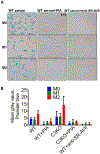Feraheme (Ferumoxytol) Is Recognized by Proinflammatory and Anti-inflammatory Macrophages via Scavenger Receptor Type AI/II
- PMID: 31556296
- PMCID: PMC7513579
- DOI: 10.1021/acs.molpharmaceut.9b00632
Feraheme (Ferumoxytol) Is Recognized by Proinflammatory and Anti-inflammatory Macrophages via Scavenger Receptor Type AI/II
Abstract
Feraheme (ferumoxytol), a negatively charged, carboxymethyl dextran-coated ultrasmall superparamagnetic iron oxide nanoparticle (USPIO, 30 nm, -16 mV), is clinically approved as an iron supplement and is used off-label for magnetic resonance imaging (MRI) of macrophage-rich lesions, but the mechanism of recognition is not known. We investigated mechanisms of uptake of Feraheme by various types of macrophages in vitro and in vivo. The uptake by mouse peritoneal macrophages was not inhibited in complement-deficient serum. In contrast, the uptake of larger and less charged SPIO nanoworms (60 nm, -5 mV; 120 nm, -5 mV, respectively) was completely inhibited in complement deficient serum, which could be attributed to more C3 molecules bound per nanoparticle than Feraheme. The uptake of Feraheme in vitro was blocked by scavenger receptor (SR) inhibitor polyinosinic acid (PIA) and by antibody against scavenger receptor type A I/II (SR-AI/II). Antibodies against other SRs including MARCO, CD14, SR-BI, and CD11b had no effect on Feraheme uptake. Intraperitoneally administered PIA inhibited the peritoneal macrophage uptake of Feraheme in vivo. Nonmacrophage cells transfected with SR-AI plasmid efficiently internalized Feraheme but not noncharged ultrasmall SPIO of the same size (26 nm, -6 mV), suggesting that the anionic carboxymethyl groups of Feraheme are responsible for the SR-AI recognition. The uptake by nondifferentiated bone marrow derived macrophages (BMDM) and by BMDM differentiated into M1 (proinflammatory) and M2 (anti-inflammatory) types was efficiently inhibited by PIA and anti-SR-AI/II antibody. Interestingly, all BMDM types expressed similar levels of SR-AI/II. In conclusion, Feraheme is efficiently recognized via SR-AI/II but not via complement by different macrophage types. The recognition by the common phagocytic receptor has implications for specificity of imaging of macrophage subtypes.
Keywords: bone marrow; iron oxide; macrophage; nanoworms; scavenger receptor; uptake.
Conflict of interest statement
The authors declare no competing financial interest.
Figures





Similar articles
-
Direct recognition of superparamagnetic nanocrystals by macrophage scavenger receptor SR-AI.ACS Nano. 2013 May 28;7(5):4289-98. doi: 10.1021/nn400769e. Epub 2013 Apr 30. ACS Nano. 2013. PMID: 23614696
-
Macrophage endocytosis of superparamagnetic iron oxide nanoparticles: mechanisms and comparison of ferumoxides and ferumoxtran-10.Invest Radiol. 2004 Jan;39(1):56-63. doi: 10.1097/01.rli.0000101027.57021.28. Invest Radiol. 2004. PMID: 14701989
-
High affinity saturable uptake of oxidized low density lipoprotein by macrophages from mice lacking the scavenger receptor class A type I/II.J Biol Chem. 1997 May 16;272(20):12938-44. doi: 10.1074/jbc.272.20.12938. J Biol Chem. 1997. PMID: 9148899
-
Emerging applications for ferumoxytol as a contrast agent in MRI.J Magn Reson Imaging. 2015 Apr;41(4):884-98. doi: 10.1002/jmri.24691. Epub 2014 Jun 30. J Magn Reson Imaging. 2015. PMID: 24974785 Review.
-
Folate-polyethylene glycol-ultrasmall superparamagnetic iron oxide nanoparticles.2011 May 9 [updated 2011 Jul 14]. In: Molecular Imaging and Contrast Agent Database (MICAD) [Internet]. Bethesda (MD): National Center for Biotechnology Information (US); 2004–2013. 2011 May 9 [updated 2011 Jul 14]. In: Molecular Imaging and Contrast Agent Database (MICAD) [Internet]. Bethesda (MD): National Center for Biotechnology Information (US); 2004–2013. PMID: 21755636 Free Books & Documents. Review.
Cited by
-
Mechanisms and Barriers in Nanomedicine: Progress in the Field and Future Directions.ACS Nano. 2024 Jun 4;18(22):13983-13999. doi: 10.1021/acsnano.4c00182. Epub 2024 May 20. ACS Nano. 2024. PMID: 38767983
-
Diagnostic and therapeutic roles of iron oxide nanoparticles in biomedicine.Tzu Chi Med J. 2022 Jul 27;35(1):11-17. doi: 10.4103/tcmj.tcmj_65_22. eCollection 2023 Jan-Mar. Tzu Chi Med J. 2022. PMID: 36866343 Free PMC article. Review.
-
Antibody-Dependent Complement Responses toward SARS-CoV-2 Receptor-Binding Domain Immobilized on "Pseudovirus-like" Nanoparticles.ACS Nano. 2022 May 4:acsnano.2c02794. doi: 10.1021/acsnano.2c02794. Online ahead of print. ACS Nano. 2022. PMID: 35507641 Free PMC article.
-
Probing immune infiltration dynamics in cancer by in vivo imaging.Curr Opin Chem Biol. 2022 Apr;67:102117. doi: 10.1016/j.cbpa.2022.102117. Epub 2022 Feb 23. Curr Opin Chem Biol. 2022. PMID: 35219177 Free PMC article. Review.
-
Superparamagnetic Iron Oxide Nanoparticles Protect Human Gingival Fibroblasts from Porphyromonas gingivalis Invasion and Inflammatory Stimulation.Int J Nanomedicine. 2022 Jan 6;17:45-60. doi: 10.2147/IJN.S333496. eCollection 2022. Int J Nanomedicine. 2022. PMID: 35027826 Free PMC article.
References
-
- Mantovani A; Sica A; Sozzani S; Allavena P; Vecchi A; Locati M The Chemokine System in Diverse Forms of Macrophage Activation and Polarization. Trends Immunol. 2004, 25, 677–86. - PubMed
-
- Weissleder R; Nahrendorf M; Pittet MJ Imaging Macrophages with Nanoparticles. Nat. Mater 2014, 13, 125–38. - PubMed
-
- Lehmann B; Biburger M; Bruckner C; Ipsen-Escobedo A; Gordan S; Lehmann C; Voehringer D; Winkler T; Schaft N; Dudziak D; Sirbu H; Weber GF; Nimmerjahn F Tumor Location Determines Tissue-Specific Recruitment of Tumor-Associated Macrophages and Antibody-Dependent Immunotherapy Response. Sci. Immunol 2017, 2, eaah6413. - PubMed
Publication types
MeSH terms
Substances
Grants and funding
LinkOut - more resources
Full Text Sources
Research Materials
Miscellaneous

